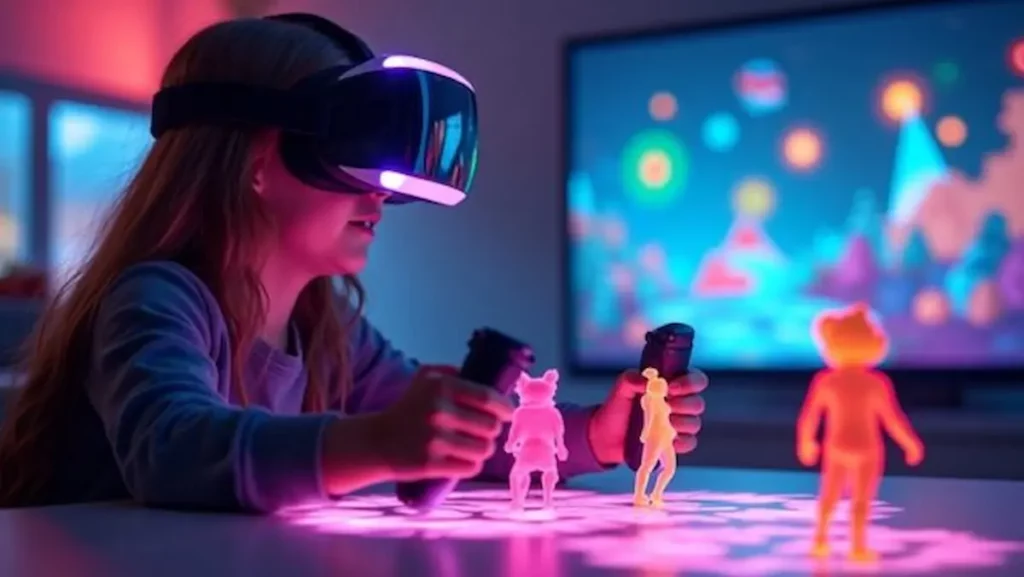
Mechanical Keyboards: they really make you a better gamer?
Find out if mechanical keyboards truly enhance gaming skills or if their benefits are just hype—discover what science and gamers reveal inside.


VR and AR are changing the way we play, turning games into something more immersive, interactive, and connected than ever before. From new ways of telling stories to reimagined multiplayer experiences, these technologies are reshaping what gaming can be. The real question is, where will VR and AR in games take us next?

Virtual reality in gaming has evolved rapidly, turning a once niche idea into a mainstream experience.
Virtual reality in gaming gained momentum as hardware became lighter, more affordable, and more powerful, while software innovations made worlds feel truly alive.
Major milestones include the move from bulky headsets to sleek devices, enabling immersive gameplay and natural interaction.
Today, virtual reality in gaming delivers deeper engagement, heightened realism, and new ways to play that keep players coming back for more.
Augmented reality games enhance the real world by overlaying digital elements onto everyday environments, creating interactive and immersive experiences.
Key augmented reality technologies include AR overlays and gesture recognition, which enable seamless interaction and real-world integration within augmented reality games.
Features like spatial audio and high visual fidelity deepen immersion, while location-based gaming and mobile compatibility improve accessibility and engagement.
Immersive storytelling through VR and AR is changing how we experience games. When virtual reality and augmented reality work together with smart narrative design, players step into interactive worlds where their choices truly matter.
This approach boosts emotional impact, makes the journey more personal, and turns classic stories into dynamic, player-driven adventures.
Immersive storytelling through VR and AR also improves engagement by activating multiple senses, helping gamers feel present inside the world.
As a result, immersive storytelling through VR and AR is redefining game narratives and setting a new standard for how stories are told in modern gaming.
VR and AR technologies significantly boost player engagement and interaction by creating immersive worlds that feel real and responsive.
This increased sense of presence gives players more agency, leading to more active participation and dynamic gameplay.
As a result, player engagement and interaction deepen, building stronger emotional connections and longer play sessions.
In modern games, this shift transforms traditional mechanics into interactive, immersive experiences that keep player engagement and interaction at the center of design.
Popular VR and AR games are leading the market with immersive experiences and innovative gameplay.
These popular VR and AR games include Beat Saber and Half-Life: Alyx, which set standards for interactive environments and storytelling.
On the AR side, Pokémon GO and The Walking Dead: Our World blend real-world exploration with digital challenges, boosting engagement and expanding the audience for mixed-reality titles.
As popular VR and AR games continue to evolve, they drive global interest and push the boundaries of what gamers expect from virtual and augmented reality.
Developing VR and AR gaming experiences comes with unique obstacles that can affect player satisfaction and project timelines. One of the biggest challenges in VR and AR gaming experiences is designing intuitive user interfaces that feel natural in 3D space.
Hardware limitations also create barriers, from motion tracking accuracy to device performance and battery life, which can impact gameplay quality and immersion. Accessibility is another key concern, as VR and AR gaming experiences must be inclusive for players with different abilities and comfort levels.
On top of that, developers must balance performance optimization with high-quality visuals, while content creation requires new workflows and tools to fully leverage immersive environments without sacrificing stability, comfort, or inclusivity.
As hardware in VR and AR gaming advances, it boosts graphical fidelity, improves tracking accuracy, and refines input methods, all of which deepen immersion.
Strong performance optimization ensures smooth gameplay, while comfortable headsets increase session length.
Accessory support, like haptic controllers and treadmills, expands interaction possibilities.
Finally, price accessibility is crucial for wider adoption, influencing how developers and players engage with virtual and augmented realities.
Social and multiplayer aspects in virtual and augmented worlds are transforming how players connect and play together.
These experiences bring people into shared spaces where friendships grow naturally through voice chat, avatar customization, and in-game events.
With strong multiplayer features, players can join cooperative missions, compete in ranked modes, and attend virtual meetups that feel like real gatherings.
As social and multiplayer aspects in virtual and augmented worlds continue to evolve, communities become more engaged, clans and guilds thrive, and players discover new ways to collaborate.
For gamers, the future is clear: social and multiplayer aspects in virtual and augmented worlds will drive deeper connections, better teamwork, and more meaningful play.
Future trends in VR and AR gaming are set to transform how we play, connect, and explore digital worlds.
As social and multiplayer features grow, future trends in VR and AR gaming will prioritize deeper immersion, better accessibility, and richer interactivity for players of all levels.
Expect major advances like improved haptic feedback, AI-driven environments that adapt to your behavior, and seamless hardware integration that reduces friction between devices.
These innovations will deliver more realistic, engaging experiences, expand the audience, and reshape what virtual entertainment can be—clearly signaling that future trends in VR and AR gaming are just getting started.
VR and AR are changing game design principles by moving beyond flat screens to fully immersive, spatial experiences.
This shift pushes developers to rethink core mechanics, visual quality, and interactive environments from the ground up.
By prioritizing player agency, seamless storytelling, strong UX, and accessibility, VR and AR reshape how games engage players.
With VR and AR at the center, designers can create more intuitive controls, more inclusive features, and more compelling gameplay that keeps players coming back.
Virtual reality and augmented reality are transforming the gaming experience by making play more immersive, interactive, and social. With VR and AR, games blend digital and real world elements, so players feel truly inside the action. This level of immersion improves storytelling, boosts emotional engagement, and opens the door to creative gameplay. As VR and AR hardware and software evolve, developers are exploring new design ideas, smarter controls, and shared multiplayer worlds. For gamers, VR and AR mean deeper connections, more personalized adventures, and fresh ways to compete and cooperate. In short, VR and AR are redefining the gaming experience and shaping the future of games for years to come.

Find out if mechanical keyboards truly enhance gaming skills or if their benefits are just hype—discover what science and gamers reveal inside.

Optimize your gaming with portable SSDs that promise faster load times on the go—discover which features truly make a difference.

Discover the key differences between noise-canceling and open-back headsets, and decide which audio style truly enhances your gaming experience.

How do Hz, resolution, and response time truly impact your gameplay? Discover what really matters before you choose your next gaming monitor.

Discover the top budget gaming laptops for 2025 that defy expectations—performance meets price, but which model truly dominates? Find out inside.

Leveraging cutting-edge tech and shifting trends, portable gaming devices are making a comeback—discover what’s driving this exciting revival today.